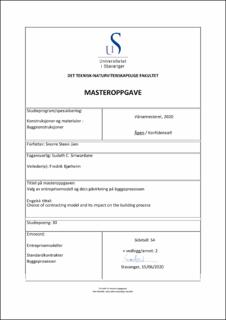| dc.contributor.advisor | Bjørheim, Fredrik | |
| dc.contributor.author | Lien, Snorre Steen | |
| dc.date.accessioned | 2020-09-25T09:07:27Z | |
| dc.date.available | 2020-09-25T09:07:27Z | |
| dc.date.issued | 2019 | |
| dc.identifier.uri | https://hdl.handle.net/11250/2679629 | |
| dc.description | Master's thesis in Structural engineering | en_US |
| dc.description.abstract | Choice of contract forms is a key decision in all building projects. This choice determines how the entire construction process will be. Different actors prefer different models, but the largest contractors in the country mostly prefers turnkey contracts. In this thesis it is chosen to focus on two types of contracting models - turnkey and shared contracts. The main difference between these is where the responsibility for design lies. In the case of a turnkey contract, a design- and build contractor is responsible for everything from design to execution, while in a shared contract it is the construction client who has the design responsibility. There are also two different contractual standards of the two contracting models - NS 8407 for turnkey contracts and NS 8405 for shared contracts.
A literature study was conducted to gain a broader understanding of the topics covered in this paper. Two different projects have also been studied - one completed with a turnkey contract and one completed with shared contracts. Key documents from the individual projects were looked at and interviews were conducted by key persons from each project.
The findings from the interviews and documents were later compared to the theory found through a literature study. The thesis looks at which factors are decisive for choosing of contracting model and how this choice influences the central processes in a building project.
From the results of the projects studied, it is clear that type of contracting model influences all the processes around a building project. Experience from the projects studied shows that it has most impact on the initial processes in the project. It shows that the distribution of responsibility is central to how the processes will be. It determines the construction client’s involvement in the project, the implementation of the project and how the collaboration gets along the way.
It is concluded that the choice of contracting model has most influence on the programming and design process in a building project. The choice determines the distribution of responsibilities during the various processes and who coordinates the entire project. From the construction client point of view, it is their competence and how much responsibility they
IV
want to have along the project that is decisive for what contracting model they choose to use in their projects.
It is important to point out that the findings made in this thesis are not representative of all construction projects. The thesis is based on experience from two projects and the findings deviate from other projects. | en_US |
| dc.language.iso | nob | en_US |
| dc.publisher | University of Stavanger, Norway | en_US |
| dc.relation.ispartofseries | Masteroppgave/UIS-TN-IMBM/2020; | |
| dc.subject | materialteknologi | en_US |
| dc.subject | byggkonstruksjon | en_US |
| dc.subject | byggeprosesser | en_US |
| dc.subject | standardkontrakter | en_US |
| dc.subject | entreprisemodeller | en_US |
| dc.subject | entrepriser | en_US |
| dc.title | Valg av entreprisemodell og dets påvirkning på byggeprosessen | en_US |
| dc.type | Master thesis | en_US |
| dc.subject.nsi | VDP::Teknologi: 500::Materialteknologi: 520 | en_US |
